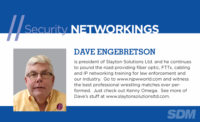I began suggesting a social media effort at Electric Guard Dog in 2010. My suggestion was met with skepticism by management due to beliefs shared by many in the security industry: too much public broadcasting of a security system can jeopardize its integrity, inappropriate or even offensive exchanges between employees or customers are a risk, as is the downloading of invasive or malicious software, and/or the posting of false information. The most frequently stated risk was a lack of return on investment (ROI): what if we spent money starting a social media program and nothing happened?
Last August, I was stunned when Electric Guard Dog Chief Executive Officer (CEO) Jack DeMao abruptly informed me I was to formulate a social media strategy that we would launch in one month’s time to support a nationwide recruiting campaign. He noted that on a previous recruiting effort, a few recruits made mention of the absence of a social media platform, so while he was still dubious, he had decided to try.
Call me Ishmael, because I was worried this would be my Moby Dick. One month to not only launch, but assist a recruiting campaign? I reviewed resources -— three hastily comprised company pages on Twitter, Facebook, and LinkedIn all missing crucial information: no updates since their creation, old messages, no pictures, no links, and/or no landing pages. Followers on Twitter and Facebook totaled a mere 30 apiece and most were former employees. LinkedIn was slightly better at 100 followers. All three sites combined totaled a mere 160 followers and more than a few were repeats. Even if I got the pages into shape in a month, I would still have no following, so how could I support recruiting, when I would be broadcasting into the abyss of cyberspace?
Nevertheless, with the incredibly wonderful help of many, the Electric Guard Dog staff and I went to work. We decided to revise and update the standard Facebook, LinkedIn and Twitter (FBLT) platforms. The only new initiative we decided to pursue was a blog, so we could post longer original content. While Pinterest use was on the rise, it was important to streamline efforts to build followings on the FBLT platforms for the time being. We wanted to focus on Twitter, as Twitter retweets are evaluated in search engine rankings.
Content
What do companies and individuals on social media want to hear from a niche market B2B security company? The answer turned out to be twofold.
The first and cardinal rule of B2B social media marketing is to share what others want to know. And not surprisingly, they don’t want to talk all day about the attributes of your product or service. At least 50 percent of content should be information as a service: links to relevant articles, notifications of training seminars, and blogs about organizational behavior at a company. Only a one-third or less should be about your product or service, or followers will drop you from their feed, just as they would switch off an annoying ad on television.
As Electric Guard Dog’s customers are frequent victims of cargo and copper theft, we adopted service platforms in both: broadcasting “be on the lookout” (BOLO) alerts in the wake of thefts, as well as magazine articles, white papers, etc.
The final third of content would be based on Electric Guard Dog’s electric security fence service. While I had physical product and service information on hand, I wanted to ensure I did not compromise the company’s first-class security system or its customers in any way. So we designed a system so all written content and pictures would be verified via the department heads of design, installation, customer service, and the CEO. It’s an ongoing process, but one that has ultimately ensured we have not received a single customer complaint since the inception of our social media program. In fact, the CEO has actually forwarded a few emails to me from customers, thanking him for the useful information we are posting.
Knowing that inappropriate or even offensive exchanges between employees or customers were a risk, our IT guy also made the wise suggestion of developing a social media policy. The document gave all employees a firm understanding of what was and wasn’t expected of them, and to this date, we’ve had no issues. Employees at headquarters have adopted the Facebook page, freely complimenting the project manager of the month, as well as building healthy competition between the inside and outside sales staff.
Early Days
Having worked at a frenzied pace to get all the pieces in place, I started posting in late September with a short-term goal of aiding a recruitment drive and a longish-term goal of reaching 1000 social media followers within six months. The first two weeks felt like the early stages of mental illness: I was talking into the air, at nobody. I sent out message after message, with no one answering the questions I posed, no one so much as “liking” or commenting on the pictures I’d accumulated. Each carefully crafted post, which had taken so long to create, took very, very little time to be absorbed into the void of cyberspace.
I thought again of the CEO’s initial fear: lack of ROI. What if we spent all that money starting a social media program and nothing happened?
I decided to focus my efforts entirely on the recruitment drive.
Unsurprisingly, our LinkedIn numbers started growing quickly with the announcement we were hiring. I did not take any credit for that growth, nor was I satisfied with it, knowing our numbers on LinkedIn could decline as rapidly as they rose, once the jobs were filled. I initiated three tenets toward recruitment:
- List the jobs on Twitter with a link to a recruitment landing page
- Post the jobs on LinkedIn forums
- Get employees at Electric Guard Dog to write and post testimonials
The last tenet had the most immediate effect. Glassdoor is a free website that allows employees to anonymously post the good and bad news of working at their company. The website is popular with job seekers and has visibility in search engines. I’d often wondered what would happen if a company were proactive in developing its Glassdoor profile, and knowing the company culture at Electric Guard Dog to be very positive, I suggested this strategy to the CEO. Within a few days, employees and ex-employees started posting reviews. The impact was huge for all involved — the reviews were so positive they attracted hot talent, the venue allowed existing employees to be part of the hiring process, and my reposting of the reviews engineered my first engagements on social media.
Followers surged on LinkedIn after the Glassdoor postings. And despite the fact that the recruiting drive ended a few weeks later, my fears of people “unlinking” were unfounded. Our LinkedIn page has continued to grow at a geometric ratio compared to other platforms, and it’s no wonder. As the one platform where everyone must be identified and accepted before they have access to your information, LinkedIn is the natural and premiere venue for both the physical and information security industries. Together they operate some of the largest discussion groups on the platform. A tectonic shift occurred on Twitter once I started participating in Follow Friday (#FF). Follow Friday is a Twitter tradition: every Friday, you post the Twitter handles of followers who have helped you, and fellow followers do the same. I started spending Friday mornings sifting through the company names offered, looking for Electric Guard Dog’s vertical markets. Participating turned out to be more than an exchange of addresses: it was the planting of our flag. The first time I participated, the biggest social media acolyte on my page retweeted one of my posts to his 32,000 followers. The next week, a blog we’d posted on the recruiting process was favorited by Reddit, the self-proclaimed “Front Page of the Internet.” We finally had sufficient visibility to be spotted from cyberspace.
In terms of lead generation, Facebook is a bit limited because company pages are stationary: only individuals can visit, like, and/or friend a company page. Additionally, few individuals care to use their personal Facebook accounts for work, so there isn’t the kind of mining you find on Twitter. But Facebook does have one redeeming quality that makes it worthwhile as a company: virtually everyone has a Facebook account. It’s a great place to publicly reward employee success, kindness and loyalty, as well as thank clients for holiday gifts. And who knows what the future holds? Facebook is now a publicly held company in search of a successful revenue stream. It continues to revise its business pages, so it is worth maintaining a page.
Conclusion
My personal goal was to gather 1000 followers between the three platforms in the space of six months. We actually achieved that goal in less than four. The CEO deemed the project a success in terms of the recruiting drive, as well as brand awareness. It is too soon to know in terms of lead generation. That will have to be another story. I’m Captain Nemo these days, not Ishmael, and like him, “the sea supplies all my wants.” Now that we have a following and we’re all accustomed to our content process, I can dedicate time each day to trolling the deep of “social listening” for lead generation opportunities. n
Top Social Media Platforms by the Numbers
- Facebook: 1 Billion+ Users*
- Twitter: 560 Million+ Users
- Google+: 400 Million+
- Instagram: 150 Million+ Users
Numbers by Leverage New Age Media





